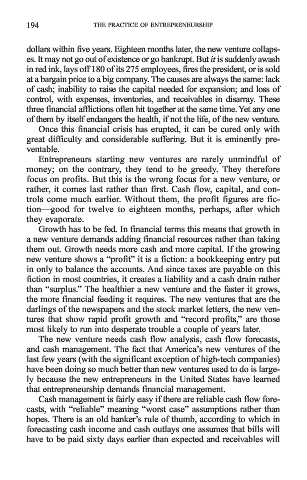Page 201 - ENTREPRENEURSHIP Innovation and entrepreneurship
P. 201
53231_Innovation and Entrepreneurship.qxd 11/8/2002 10:50 AM Page 194
194 THE PRACTICE OF ENTREPRENEURSHIP
dollars within five years. Eighteen months later, the new venture collaps-
es. It may not go out of existence or go bankrupt. But it is suddenly awash
in red ink, lays off 180 of its 275 employees, fires the president, or is sold
at a bargain price to a big company. The causes are always the same: lack
of cash; inability to raise the capital needed for expansion; and loss of
control, with expenses, inventories, and receivables in disarray. These
three financial afflictions often hit together at the same time. Yet any one
of them by itself endangers the health, if not the life, of the new venture.
Once this financial crisis has erupted, it can be cured only with
great difficulty and considerable suffering. But it is eminently pre-
ventable.
Entrepreneurs starting new ventures are rarely unmindful of
money; on the contrary, they tend to be greedy. They therefore
focus on profits. But this is the wrong focus for a new venture, or
rather, it comes last rather than first. Cash flow, capital, and con-
trols come much earlier. Without them, the profit figures are fic-
tion—good for twelve to eighteen months, perhaps, after which
they evaporate.
Growth has to be fed. In financial terms this means that growth in
a new venture demands adding financial resources rather than taking
them out. Growth needs more cash and more capital. If the growing
new venture shows a “profit” it is a fiction: a bookkeeping entry put
in only to balance the accounts. And since taxes are payable on this
fiction in most countries, it creates a liability and a cash drain rather
than “surplus.” The healthier a new venture and the faster it grows,
the more financial feeding it requires. The new ventures that are the
darlings of the newspapers and the stock market letters, the new ven-
tures that show rapid profit growth and “record profits,” are those
most likely to run into desperate trouble a couple of years later.
The new venture needs cash flow analysis, cash flow forecasts,
and cash management. The fact that America’s new ventures of the
last few years (with the significant exception of high-tech companies)
have been doing so much better than new ventures used to do is large-
ly because the new entrepreneurs in the United States have learned
that entrepreneurship demands financial management.
Cash management is fairly easy if there are reliable cash flow fore-
casts, with “reliable” meaning “worst case” assumptions rather than
hopes. There is an old banker’s rule of thumb, according to which in
forecasting cash income and cash outlays one assumes that bills will
have to be paid sixty days earlier than expected and receivables will

